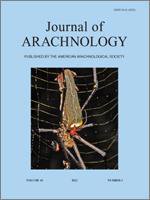Subsocial spiders are located on the continuum between solitary species and social species and are characterized by extended maternal care, some cooperation in foraging and colony activities and dispersal in order to found new colonies. In the genus Anelosimus (Araneae: Theridiidae), up to nine species are thought to be subsocial. One of these spiders, A. baeza Agnarsson (2006), is distributed across a large geographical range from Mexico to southern Brazil, and potential differences in behavior in different populations are unknown. We studied the ecology and behavior of a population of A. baeza in a cloud forest habitat in Mexico. We tracked the population for ten months, analyzed the degree of cooperation and the presence of associated species, and explored the settling decisions made by dispersing spiders. We show that the breeding season for A. baeza in Mexico differs from other populations elsewhere in South America. Using a kinematic diagram, we recorded the sequence of behaviors involved in subduing and feeding on a model prey species. Larger colonies harbored more associated species. Anelosimus baeza prefers to settle in locations that already contain conspecifics or silk. Our study demonstrates that A. baeza is a viable candidate for research into sociality in spiders and its geographical correlates.
How to translate text using browser tools
1 November 2012
Notes on the ecology and behavior of a subsocial spider Anelosimus baeza (Araneae: Theridiidae) in Mexico
Dinesh Rao,
Alfonso Aceves-Aparicio
ACCESS THE FULL ARTICLE

The Journal of Arachnology
Vol. 40 • No. 3
November 2012
Vol. 40 • No. 3
November 2012
araneophagy
demography
foraging
kinematic diagram
sociality




